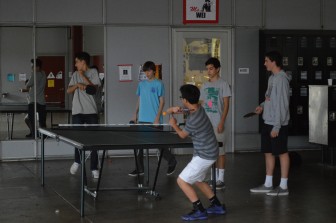
“Call them the Aragon afternoon squad or what you will: the collection of students participating in activities like dance, sports, theatre, and clubs contributes to the creation of a uniquely Aragonian afterschool community.
The vibrancy of the afterschool community begins at an individual. Senior Kaitlyn Cooperstein, a tennis player, says, “Well, I was drawn to the positive environment. I also wanted to be active, and tennis is a fun sport. Also, it helps me manage my time wisely.”

Interactions amongst team members within the same activity may also strengthen the collective bond. Cooperstein says, “As for the positive environment, we are all super helpful for playing tennis. If one of us sees something that someone is doing wrong and is hurting their game, we will always tell them to help out.”
Similarly, support from team members may, in fact, serve as further motivation for an individual. Senior Jeffrey Song says, “I started cross-country in middle school because my friends convinced me, and I wasn’t that enthusiastic. However, over time, with hard work and motivation, [in high school] I made varsity. Then, we made it to state. I’ve grown to love cross-country more.”
While members who participate in different activities may not share the same experiences, the common thread of being part of the same community sets a foundation of understanding. Senior Ryan McAuliffe says, “I think each category [sports, drama, etc.] has a certain respect for [what others do in their] afterschool activities because we know what other people are going through.”
The sense of unity creates the Aragon afterschool community. Cooperstein says, “The environment is very positive and encouraging. We may not all be best friends or all that close, but if one of us needs something, we will help each other out. For example, our Carlmont matches every year really get us mad because their #1 doubles team makes bad line calls, [and] we always are there for support no matter what.”
 Aside from the spirit, being in the afterschool community offers individuals opportunities to create new relationships. Freshman Emily Xu says, “Clubs, sports, theatre, spirit squad, and any other of the extracurriculars that include multiple grades definitely give people the chance to know different grades of people, especially if they don’t attend a class that’s mixed. We [the dance team] improve together, give encouragement and critiques so that we can all give a great performance by the end of the week. We work towards a common goal, and so we help one another.”
Aside from the spirit, being in the afterschool community offers individuals opportunities to create new relationships. Freshman Emily Xu says, “Clubs, sports, theatre, spirit squad, and any other of the extracurriculars that include multiple grades definitely give people the chance to know different grades of people, especially if they don’t attend a class that’s mixed. We [the dance team] improve together, give encouragement and critiques so that we can all give a great performance by the end of the week. We work towards a common goal, and so we help one another.”
Beyond social opportunities, the afterschool community fosters growth in areas not emphasized during school hours. English teacher Genevieve Thurtle says, “I think that students who are there after school tend to be participating in an organized activity, like sports or drama. This time allows students to develop other areas of their lives — ones that they can’t necessarily develop in the classroom.”
While afterschool activities require a necessary sacrifice of time, Xu says, “If people aren’t involved already, I highly recommend it. In middle school, I wasn’t very involved in the first two years, so they were much less exciting than my eighth grade year. Extracurriculars are what define your high school life and makes it exciting.”
The afterschool community at Aragon molds one’s high school experience and gives students everlasting memories. This community brings people together with common interests and provides another family students can feel a part of. Xu says, “The afterschool community connects people that otherwise would’ve been strangers. They allow people to share the excitement that comes with participating.” “



